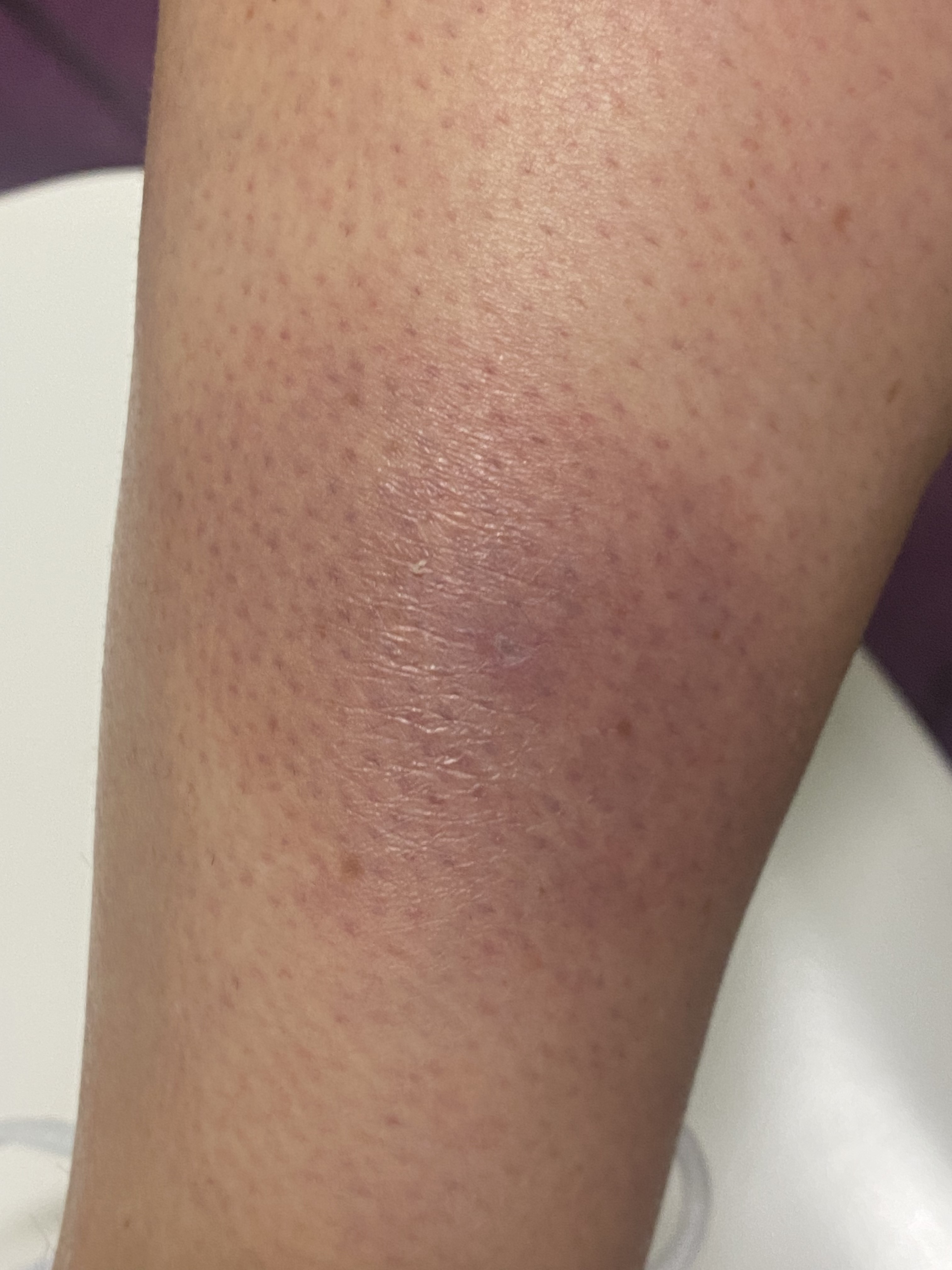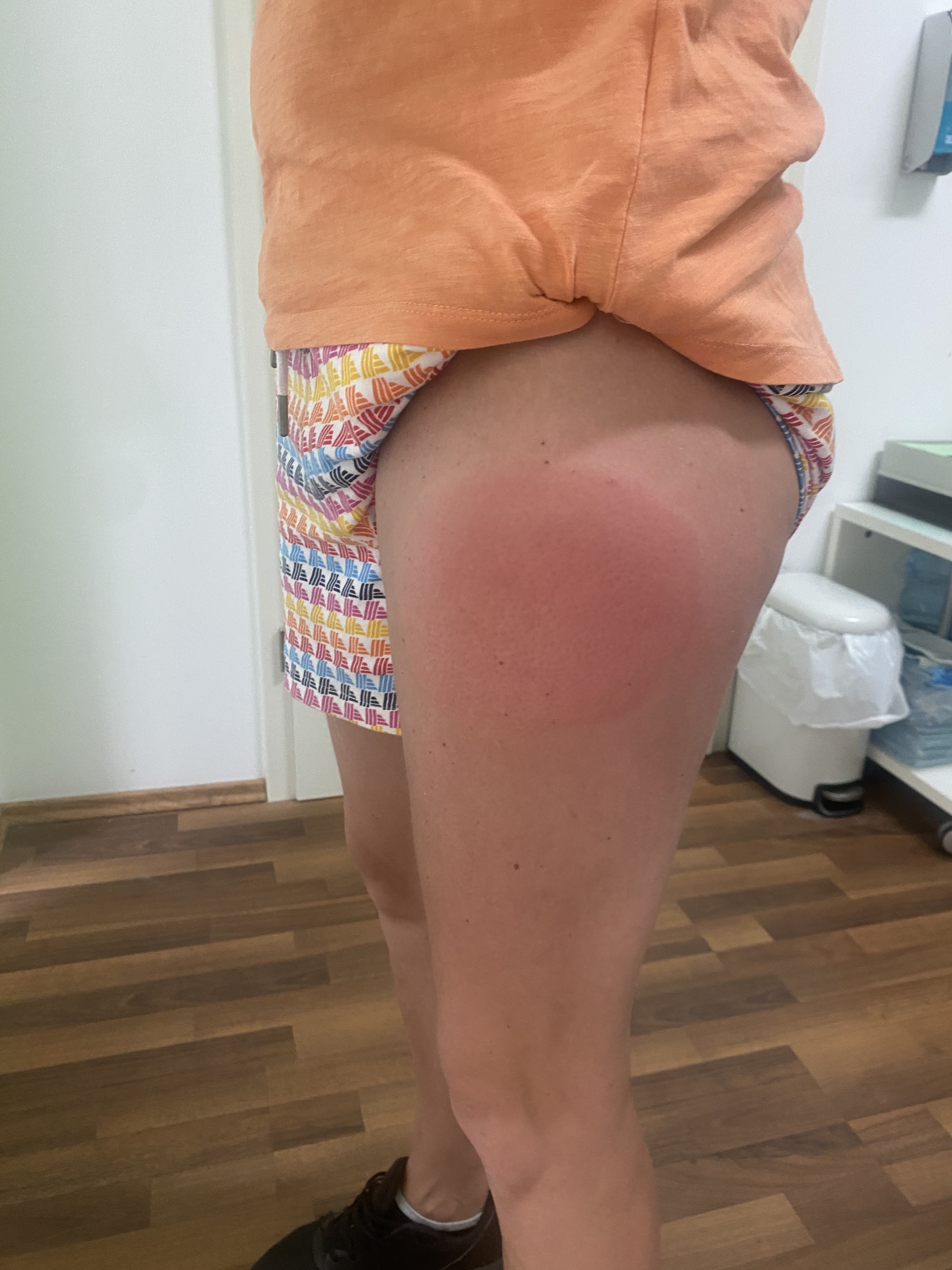Therapy and progression:
The skin findings with the almost circular reddening and the central erosive defect literally force a visual diagnosis of a sting reaction. The severe inflammation can now correspond either to a toxic-allergic reaction to the biogenic proteins or toxins introduced by the act of suction or to pyoderma (erysipelas, phlegmon) due to secondary infection with bacteria. While localised itching and burning is typical of the former, a systemic reaction with fever, chills and a generally reduced condition predominates in the latter; allergic reactions can cause systemic symptoms.
Severe insect bite reactions in northern latitudes are most likely to be caused by horseflies, midges and mosquitoes. In contrast to bee or wasp stings with immediate severe pain and rather urticarial local or disseminated urticarial reaction, inflammation and infiltrate often begin protracted, at least when the stinging insect has already flown away. The causes are neurological and anticoagulant (haemorrhagic sting site) as well as local anaesthetic proteins.
The tick also sucks blood via its proboscis. However, if it is infected with Borrelia, these gram-negative bacteria can spread centrifugally via the dermal lymphatic clefts. The tick's Borrelia reservoir is the intestine, but transmission takes place via the saliva during the act of sucking. The tick must suck for several hours for borrelia to be transmitted.
If a small reddening usually corresponds to a harmless sting reaction, the "travelling rash" is an expression of a Borrelia infection. The various definitions of migratory erythema, with an erythema diameter of 3 to 5 cm, may be indicative, but cannot provide 100% certainty. The typical finding is solitary marginal reddening with central blanching that gives the region a disc-shaped aspect, but even this is not a reliable criterion. The lesions can also appear oval, polycyclic or streaky. And there may also be pronounced, alarming dark red inflammatory infiltrated findings. Multi-locular erythema chronicum migrans (ECM) foci are less common. Finally, the Borrelia infection of the skin can also be inapparent.
It is very important to take a precise medical history, as the ECM follows the tick bite with a time delay of 3 days to several weeks (Incubation Period 3 to 30 days, median 7 to 10 days), i.e. much later than the onset of the usual bite reaction. In some cases, patients can remember a tick stuck in their skin, which is unusual for all other arthropod attacks.
In the present case, according to the image documentation of the tick bite presented later (Fig. 2), the diagnosis of a severe inflammatory erythema chronicum migrans was made on the basis of the patient, the time course and also the completely ineffective antibiotic treatment with clindamycin. This could finally also be verified in the borrelia serology, although the first blood sample was still at the edge of the diagnostic window and only subsequently produced clearer results (Table 1).



Fig. 2: Tick feeding on the lower leg. The inflammatory reddening of the surrounding area corresponds to the initial general bite reaction (photo taken by the patient a few days before the onset of erythema chronicum migrans).
In principle, serology is a diagnostic tool that supports the suspected clinical diagnosis. There is no single optimal test for the detection of antibodies. For this reason, serodiagnostics follow the principle of step-by-step diagnostics: ELISA or comparable methods are recommended for the first stage. In the case of positive or borderline results from stage 1, the immunoblot is carried out as a confirmatory test in stage 2. This is subject to special quality requirements (Source: Robert Koch Institute Guide, In German only). If the 1st stage test is positive or borderline, the 2nd stage test (immunoblot) is carried out. Special quality requirements must be met for the immunoblot as a confirmatory test. Erythema chronicum migrans, like borrelia lymphocytoma, represents the early localised stage of Lyme disease. Table 2 provides an overview of other Lyme disease stages.
Table 2: Overview of the manifestations of Lyme disease depending on its stage. If the early stages are visible within days or weeks, the late stages only manifest themselves after years (Source: Robert Koch Institute Guide, In German only)
|
Stage |
Skin Manifestation |
Neurological Manifestation |
Other Manifestations |
|
early focalisation |
Erythema migrans; Borrelial Lymphocytoma |
||
|
early dissemination |
multiple Erythemata migrantia; multiple Borrelial Lymphocytoma |
early neuroborreliosis (lymphocytic meningitis, meningoradiculitis, cranial nerve palsies) |
Lyme carditis; early (transient) Lyme arthritis; very rarely: eye complications |
|
Late |
Acrodermatitis chronica athrophicans (ACA) |
Late neuroborreliosis (encephalomyelitis; cerebral vasculitis, peripheral neuropathy associated with ACA) |
Chronic Lyme arthritis (mono-oligoarthritis) |
The treatment of first choice is still oral doxycycline at 200mg/d for 14 to 21 days. Alternative therapies are amoxicillin or cerfuroximaxetil. Intravenous alternatives are ceftriaxone, cefuroxime or penicillin G, which are, however, more commonly used in advanced stages of Lyme disease.
The standard therapy with oral doxycycline 200mg that was initiated in the present case was discontinued by the patient after only 4 days due to gastrointestinal intolerance. At the patient's request, treatment was initially suspended for 10 days for recovery and because of another planned holiday. Around week 4 after the start of HE, the patient was then switched to an alternative antibiotic treatment with oral cerfuroxime 500 1-1/ for 2 weeks while the skin symptoms remained unchanged. This resulted in a clear fading of the inflammatory skin symptoms after just one week and almost complete healing after 3 weeks (Fig. 3).

a

b

c
Fig. 3: Skin symptoms after 2-week antibiotic treatment with oral doxycycline 200mg/d (a,b). The previously clear infiltration has subsided, but post-inflammatory hyperpigmentation is still visible (c).
Erythema chronicum migrans always requires a differential diagnosis. As mentioned above, an insect bite reaction occurs without a clear interval (Fig. 4).

a

b
Fig. 4: 32-year-old female patient after a wasp sting in the thigh (a). The erythema is urticarial, i.e. raised like a beetle, and is a direct consequence of the hymenoptera sting (b).
Tinea corporis (body ringworm) shows erythrosquamous plaques with marginal scaling and central atrophy as well as frequent strangulation of satellite lesions (Fig. 5).


Fig. 5: 19-year-old vocational school student with tinea corporis caused by Trichophyton benhamiae ("guinea pig fungus", or ringworm). Characteristic scaling due to the epidermal involvement and the ring morph.
Erysipelas (in the upper dermis) shows tongue-shaped extensions and minor injuries can often be detected.
The fixed drug reaction usually shows several livid red foci and there is an anamnestic reference. Finally, Granuloma annulare (GA) manifests itself with ring-shaped subcutaneous lesions In children, erythema infectiosum (also known as "fifth disease") can be recognised by multiple lesions involving the face, and a parvovirus B19 infection can be detected in the laboratory.
Granuloma annulare is a self-limiting, asymptomatic, necrobiotic, granulomatous inflammation of the skin with skin-coloured on papules or plaques, often with anular outline. It is often associated with diabetes mellitus (Fig. 6).


Fig. 6: Granuloma anulare in a 51-year-old female patient with type 1 diabetes mellitus.
Whether Lyme disease in Germany can also be transmitted by mosquitoes has long been the subject of controversial debate. In fact, there have been isolated cases of migratory rubella transmitted by mosquito bites. According to studies carried out at the Climate Research Centre at Goethe University Frankfurt on 3,600 mosquitoes from 42 German locations, Borrelia genes have now been detected in the insects' saliva. Using complex molecular biological methods, the genes of the most important pathogenic Borrelia species in Germany, Borrelia afzelii, Borrelia bavariensis and Borrelia garnis, have been identified. Nevertheless, the real risk is extremely low, probably also because the mosquitoes' dwell time during the sucking act is rather short. And even after a tick bite, only 1.5% to 6% of those affected become infected, as the human immune system is usually able to fight off the pathogen effectively. [Source: Native mosquitoes can transmit Lyme disease, Spiegel-Gesundheit 24/03/2016 (Only available in German)].
Risk assessment by endemic area has become less important for Germany, as ticks with Tick-borne encephalitis (TBE) and Borrelia are becoming increasingly prevalent throughout the country. Infected ticks have also spread from Germany's Mecklenburg-Western Pomerania to the wooded Baltic Sea coasts and dunes. This is probably due to the rainy summers and warm winters.
Conclusion
The "travelling rash" is the characteristic early stage of Lyme borreliosis, which is usually transmitted by ticks. It develops in a centrifugal disc shape around the epicentre of the tick bite. Due to the highly variable aspect, a reliable diagnosis requires both visual diagnostic assessment and borrelia serology, taking into account the diagnostic window.
Important differential diagnoses include erysipelas, tinea corporis, insect bite reactions and erythema grannulare. Infected ticks can now be found in forests and meadows throughout Germany. Timely systemic antibiotic therapy with aerological therapy success control is important to prevent a chronic-stage course with partly irreversible cutaneous, rheumatic-cardinal and -arthritic as well as neurological symptoms.



